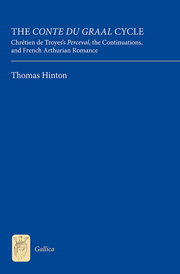 The Conte du Graal Cycle
The Conte du Graal Cycle Book contents
- Frontmatter
- Contents
- List of illustrations
- Acknowledgments
- List of Abbreviations
- Manuscript Sigla
- Introduction
- 1 Narrative Aesthetic and Cyclic Formation
- 2 Manuscripts, Memory and Textual Transmission
- 3 Authorship, Kinship and the Ethics of Continuation
- 4 Rereading the Evolution of Arthurian Verse Romance
- Conclusion
- Appendix 1 Narrative Summaries
- Appendix 2 Lengths and Dates of Texts
- Appendix 3 Manuscripts of the Conte du Graal Cycle
- Appendix 4 Full Contents of Conte du Graal Cycle manuscripts
- Appendix 5 Arthurian Verse Romances: Dates and Manuscripts
- Appendix 6 Contents of Arthurian Verse Romance Manuscripts
- Bibliography
- General Index
- Index of Manuscripts
- Miscellaneous Endmatter
1 - Narrative Aesthetic and Cyclic Formation
Published online by Cambridge University Press: 05 September 2013
- Frontmatter
- Contents
- List of illustrations
- Acknowledgments
- List of Abbreviations
- Manuscript Sigla
- Introduction
- 1 Narrative Aesthetic and Cyclic Formation
- 2 Manuscripts, Memory and Textual Transmission
- 3 Authorship, Kinship and the Ethics of Continuation
- 4 Rereading the Evolution of Arthurian Verse Romance
- Conclusion
- Appendix 1 Narrative Summaries
- Appendix 2 Lengths and Dates of Texts
- Appendix 3 Manuscripts of the Conte du Graal Cycle
- Appendix 4 Full Contents of Conte du Graal Cycle manuscripts
- Appendix 5 Arthurian Verse Romances: Dates and Manuscripts
- Appendix 6 Contents of Arthurian Verse Romance Manuscripts
- Bibliography
- General Index
- Index of Manuscripts
- Miscellaneous Endmatter
Summary
In this chapter I will examine how narrative aesthetic is created, promoted and contested at different points in the Conte du Graal cycle. Such a long text, with multiple authors, will inevitably change as it progresses, with successive authors choosing how to develop the narrative project inherited from their predecessors. Moreover, parts of the corpus were substantially rewritten, perhaps several times over, during the text's manuscript transmission. The following discussion will track this complex process, arguing that the cyclification of the Conte du Graal material is characterised by the imposition of two related narrative structures onto earlier, more centrifugal material: interlace, where multiple knights' adventures are woven together, and biography, with Perceval's chivalric and moral progression becoming the text's central concern. Particular attention will be paid to material which recurs or is reworked several times through the corpus, taking account of the whole manuscript tradition of the cycle. I leave until Chapter 2 a consideration of what the manuscript presentation of the cycle can tell us about its reception, focusing here on how narrative structures work to produce and promote specific textual aesthetics.
The structure of this chapter acknowledges a distinction between the diachronic and synchronic study of cyclicity – that is, the study of cyclic formation through time (the diachronic dimension) and that of the cyclic properties of an ensemble at a given stage of that formation (the synchronic dimension). Diachronic analysis traces the development of non-cyclic into cyclic material, often through successive stages in manuscript transmission; synchronic analysis considers a given cyclic manuscript or set of manuscripts as a specific and self-sufficient instance of cyclicity.
- Type
- Chapter
- Information
- The Conte du Graal CycleChrétien de Troyes's Perceval, the Continuations, and French Arthurian Romance, pp. 29 - 69Publisher: Boydell & BrewerPrint publication year: 2012


